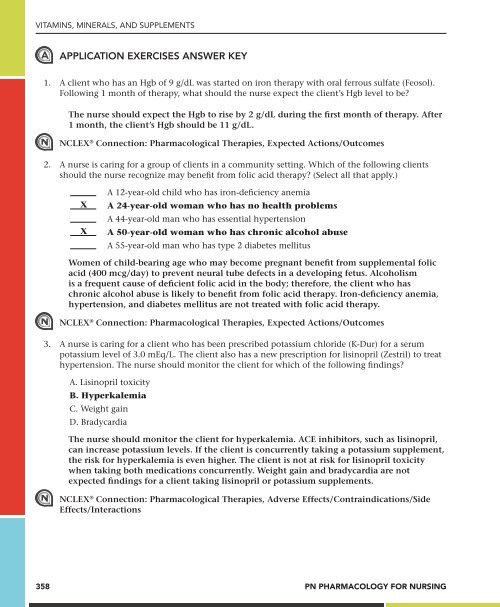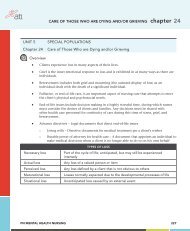chapter 28 - ATI Testing
chapter 28 - ATI Testing
chapter 28 - ATI Testing
Create successful ePaper yourself
Turn your PDF publications into a flip-book with our unique Google optimized e-Paper software.
VITAMINS, MINERALS, AND SUPPLEMENTS<br />
APPLIC<strong>ATI</strong>ON EXERCISES ANSWER kEY<br />
1. A client who has an Hgb of 9 g/dL was started on iron therapy with oral ferrous sulfate (Feosol).<br />
Following 1 month of therapy, what should the nurse expect the client’s Hgb level to be?<br />
The nurse should expect the Hgb to rise by 2 g/dL during the first month of therapy. After<br />
1 month, the client’s Hgb should be 11 g/dL.<br />
NCLEX ® Connection: Pharmacological Therapies, Expected Actions/Outcomes<br />
2. A nurse is caring for a group of clients in a community setting. Which of the following clients<br />
should the nurse recognize may benefit from folic acid therapy? (Select all that apply.)<br />
A 12-year-old child who has iron-deficiency anemia<br />
X A 24-year-old woman who has no health problems<br />
A 44-year-old man who has essential hypertension<br />
X A 50-year-old woman who has chronic alcohol abuse<br />
A 55-year-old man who has type 2 diabetes mellitus<br />
Women of child-bearing age who may become pregnant benefit from supplemental folic<br />
acid (400 mcg/day) to prevent neural tube defects in a developing fetus. Alcoholism<br />
is a frequent cause of deficient folic acid in the body; therefore, the client who has<br />
chronic alcohol abuse is likely to benefit from folic acid therapy. Iron-deficiency anemia,<br />
hypertension, and diabetes mellitus are not treated with folic acid therapy.<br />
NCLEX ® Connection: Pharmacological Therapies, Expected Actions/Outcomes<br />
3. A nurse is caring for a client who has been prescribed potassium chloride (K-Dur) for a serum<br />
potassium level of 3.0 mEq/L. The client also has a new prescription for lisinopril (Zestril) to treat<br />
hypertension. The nurse should monitor the client for which of the following findings?<br />
A. Lisinopril toxicity<br />
B. Hyperkalemia<br />
C. Weight gain<br />
D. Bradycardia<br />
The nurse should monitor the client for hyperkalemia. ACE inhibitors, such as lisinopril,<br />
can increase potassium levels. If the client is concurrently taking a potassium supplement,<br />
the risk for hyperkalemia is even higher. The client is not at risk for lisinopril toxicity<br />
when taking both medications concurrently. Weight gain and bradycardia are not<br />
expected findings for a client taking lisinopril or potassium supplements.<br />
NCLEX ® Connection: Pharmacological Therapies, Adverse Effects/Contraindications/Side<br />
Effects/Interactions<br />
358 PN PHARMACOLOGY FOR NURSING










